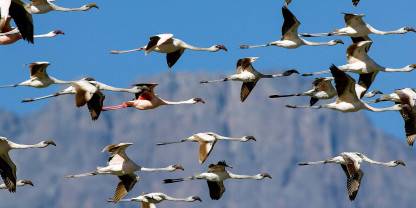Average Expert Rating
Rating Breakdown
Write a User ReviewBelow Mount Meru
This small national park doesn’t score too highly as a conventional safari destination – of the so-called Big Five, elephant are rather uncommon, leopard scarce, and lion and rhino absent altogether. Taken on its own terms, however, it makes for a wonderful excursion from northern Tanzania’s self-styled ‘safari capital’, the town of Arusha, which lies less than an hour’s drive away.
Geographically, the dominant feature of Arusha National Park is the 4,566m/14,980ft Mount Meru, the fifth-highest mountain in Africa. Even if you don’t attempt a full 3-day ascent of this dormant volcano, a relatively undemanding guided day hike through the forested slopes into the spectacular semi-collapsed caldera is highly recommended.
My favourite part of the park is the forested slopes of the stunning Ngurdoto Crater. This is a good place to see the acrobatic black-and-white colobus, the inquisitive blue monkey, and a host of forest birds including the brightly
Aquatic birds are the main attraction of the Momella Lakes, which sometimes host large concentrations of flamingos and migrant waterfowl, and can also now be explored on canoe safaris, a welcome change of pace after a few game drives. On our most recent visit to this area, we also lucked good sightings of two seldom-observed small felids: African wild cat and serval. And on a clear evening, the lakes offer splendid views west to Kilimanjaro, whose snowcapped peak, only 50km/30mi distant, usually emerges from its cloudy shroud in the late afternoon.
Geographically, the dominant feature of Arusha National Park is the 4,566m/14,980ft Mount Meru, the fifth-highest mountain in Africa. Even if you don’t attempt a full 3-day ascent of this dormant volcano, a relatively undemanding guided day hike through the forested slopes into the spectacular semi-collapsed caldera is highly recommended.
My favourite part of the park is the forested slopes of the stunning Ngurdoto Crater. This is a good place to see the acrobatic black-and-white colobus, the inquisitive blue monkey, and a host of forest birds including the brightly
Read more
coloured Hartlaub’s turaco and noisy silvery-cheeked hornbill. There is also a lovely viewpoint from the rim to the swampy green crater floor, a favoured haunt of buffalo and warthog.Aquatic birds are the main attraction of the Momella Lakes, which sometimes host large concentrations of flamingos and migrant waterfowl, and can also now be explored on canoe safaris, a welcome change of pace after a few game drives. On our most recent visit to this area, we also lucked good sightings of two seldom-observed small felids: African wild cat and serval. And on a clear evening, the lakes offer splendid views west to Kilimanjaro, whose snowcapped peak, only 50km/30mi distant, usually emerges from its cloudy shroud in the late afternoon.
Meru and the Flamingos
Arusha National Park is a small, attractive and easily accessed African reserve. At 13,700 hectares, the park offers a surprising diversity of habitats and wildlife within a remarkably compact area. But, wildlife aside, Arusha National Park is one of the most beautiful and topographically varied park’s in Tanzania, boasting rugged Mount Meru (4,566m), the multi-coloured and flamingo-filled Momela lakes, and three-kilometre-wide Ngurdoto Crater (a miniature version of Ngorongoro).
Arusha National Park is not a good choice for serious Big Five enthusiasts. Although buffalo are common, the park’s elephants and leopards are shy, and there are no lions or rhino present. The prime attraction is Kilimanjaro’s little brother with trekkers coming from far and wide to scale Tanzania’s second highest peak. After hiking through wooded savannah popular with buffalo, zebra and giraffe, the ascent continues into forests ablaze with red-hot pokers and drenched with Spanish moss.
Arusha National Park is not a good choice for serious Big Five enthusiasts. Although buffalo are common, the park’s elephants and leopards are shy, and there are no lions or rhino present. The prime attraction is Kilimanjaro’s little brother with trekkers coming from far and wide to scale Tanzania’s second highest peak. After hiking through wooded savannah popular with buffalo, zebra and giraffe, the ascent continues into forests ablaze with red-hot pokers and drenched with Spanish moss.

